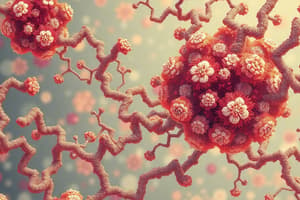Podcast
Questions and Answers
Which functional groups are present in all amino acids?
Which functional groups are present in all amino acids?
- Carboxyl group, amino group, and side chain (R group) (correct)
- Methyl group, amino group, and side chain (R group)
- Carbonyl group, hydroxyl group, and side chain (R group)
- Carboxyl group, amino group, and phosphate group
How do GLYCINE and PROLINE differ from the other 20 amino acids?
How do GLYCINE and PROLINE differ from the other 20 amino acids?
- They are the only amino acids with a different number of hydrogen atoms
- They are the only amino acids containing a phosphate group
- They are the only amino acids with a hydroxyl group
- They are the only amino acids occurring in the L- α form (correct)
How are amino acids classified based on chemical classification?
How are amino acids classified based on chemical classification?
- Based on the presence of aromatic rings in the side chains (R-groups)
- Based on the number of hydrogen atoms in the side chains (R-groups)
- Based on the length of the side chains (R-groups)
- Based on the solubility and ionization at physiological pH as determined by the side chains (R-groups) (correct)
What is the function of proteins of high biological value?
What is the function of proteins of high biological value?
What is the significance of protein folding/misfolding?
What is the significance of protein folding/misfolding?
How many amino acids are occurring in the human body?
How many amino acids are occurring in the human body?
Which type of amino acids prefer to function in an aquas environment?
Which type of amino acids prefer to function in an aquas environment?
Which amino acid is purely ketogenic in nature?
Which amino acid is purely ketogenic in nature?
What occurs in negative nitrogen balance?
What occurs in negative nitrogen balance?
Which type of amino acids cannot be synthesized in the human body and must be supplied in the diet?
Which type of amino acids cannot be synthesized in the human body and must be supplied in the diet?
Which group of amino acids is classified as non-essential (dispensable)?
Which group of amino acids is classified as non-essential (dispensable)?
Which amino acid has a hydrocarbon or alkyl side chain?
Which amino acid has a hydrocarbon or alkyl side chain?
What do glucogenic amino acids give rise to on catabolism?
What do glucogenic amino acids give rise to on catabolism?
Which type of amino acids have side chains that contain aromatic side chains?
Which type of amino acids have side chains that contain aromatic side chains?
What happens in positive nitrogen balance?
What happens in positive nitrogen balance?
Flashcards
Amino Acid Commonality?
Amino Acid Commonality?
All have an alpha amino group, a carboxyl group, and a side chain.
Amino Acid Groups?
Amino Acid Groups?
Amino acids are classified into acidic, basic, neutral, and aromatic.
High Biological Value Proteins?
High Biological Value Proteins?
Provide all essential amino acids for human health.
Protein Folding?
Protein Folding?
Signup and view all the flashcards
Standard Amino Acids?
Standard Amino Acids?
Signup and view all the flashcards
Hydrophilic Amino Acids?
Hydrophilic Amino Acids?
Signup and view all the flashcards
Leucine?
Leucine?
Signup and view all the flashcards
Negative Nitrogen Balance?
Negative Nitrogen Balance?
Signup and view all the flashcards
Essential Amino Acids?
Essential Amino Acids?
Signup and view all the flashcards
Non-Essential Amino Acids?
Non-Essential Amino Acids?
Signup and view all the flashcards
Amino Acids with Alkyl Side Chains?
Amino Acids with Alkyl Side Chains?
Signup and view all the flashcards
Glucogenic Amino Acids?
Glucogenic Amino Acids?
Signup and view all the flashcards
Aromatic Amino Acids?
Aromatic Amino Acids?
Signup and view all the flashcards
Protein Misfolding?
Protein Misfolding?
Signup and view all the flashcards
Positive Nitrogen Balance?
Positive Nitrogen Balance?
Signup and view all the flashcards
Study Notes
Amino Acid Characteristics
- All amino acids have an alpha amino group, a carboxyl group, and a side chain.
- GLYCINE and PROLINE differ from the other 20 amino acids in that they have a secondary amino group and a cyclic structure, respectively.
Amino Acid Classification
- Amino acids are classified into acidic, basic, neutral, and aromatic based on their chemical properties.
Protein Functions
- Proteins of high biological value provide all essential amino acids for human health.
- Proteins are crucial for growth, maintenance, and repair of body tissues.
Protein Folding and Misfolding
- Protein folding is essential for protein function and stability.
- Protein misfolding can lead to various diseases, such as Alzheimer's and Parkinson's.
Amino Acid Occurrence
- There are approximately 20 standard amino acids that occur in the human body.
Amino Acid Preferences
- Hydrophilic (polar) amino acids prefer to function in an aquatic environment.
Ketogenic Amino Acids
- Leucine is purely ketogenic in nature, meaning it is converted to acetoacetate and acetyl-CoA during catabolism.
Nitrogen Balance
- Negative nitrogen balance occurs when the body breaks down more protein than it synthesizes, resulting in muscle wasting.
- Positive nitrogen balance occurs when the body synthesizes more protein than it breaks down, resulting in muscle growth.
Essential Amino Acids
- Essential amino acids cannot be synthesized in the human body and must be supplied in the diet. Examples include phenylalanine, valine, and isoleucine.
Non-Essential Amino Acids
- Non-essential (dispensable) amino acids can be synthesized in the human body from other amino acids. Examples include alanine, aspartic acid, and glutamic acid.
Amino Acid Side Chains
- Amino acids with hydrocarbon or alkyl side chains are classified as non-polar, such as alanine and valine.
Glucogenic Amino Acids
- Glucogenic amino acids give rise to glucose or glucogenic intermediates during catabolism. Examples include glycine and serine.
Aromatic Amino Acids
- Aromatic amino acids have side chains that contain aromatic rings, such as phenylalanine, tyrosine, and tryptophan.
Studying That Suits You
Use AI to generate personalized quizzes and flashcards to suit your learning preferences.




